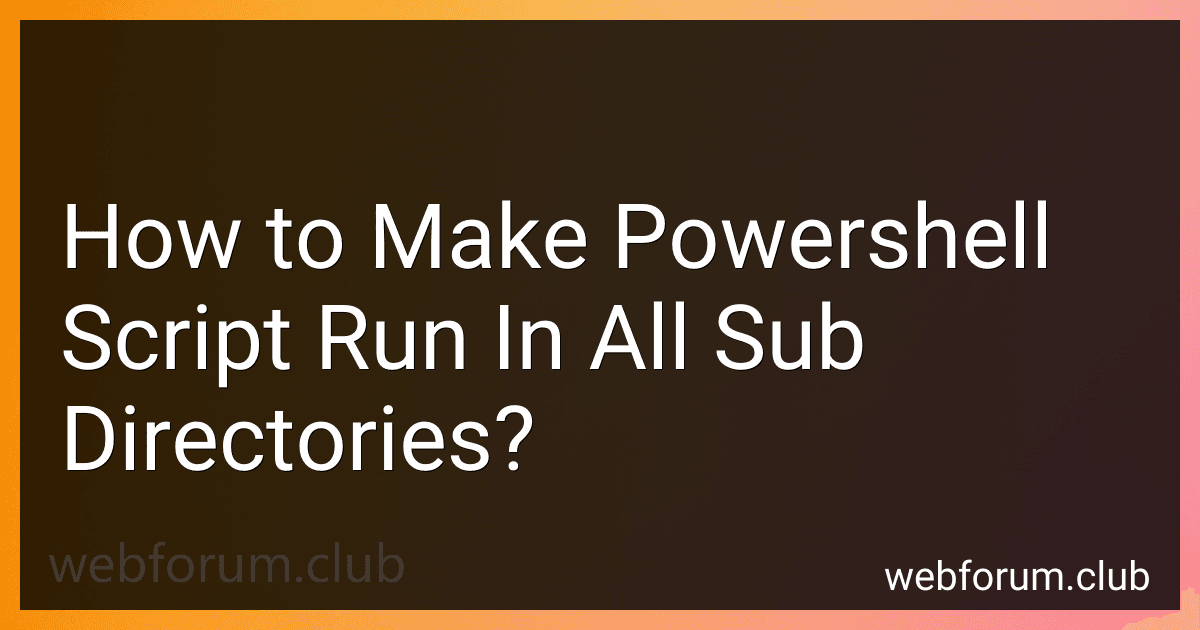To make a PowerShell script run in all subdirectories, you can use the Get-ChildItem cmdlet to recursively search for all directories and then run your script in each of them. You can also use a foreach loop to iterate through each subdirectory and execute your script. Additionally, you can use the -Recurse parameter with the Invoke-Command cmdlet to run your script in all subdirectories recursively. Finally, you can create a function that accepts a directory path as a parameter and then runs your script in that directory and all its subdirectories.
What is the PowerShell command to apply a script to all subdirectories?
To apply a script to all subdirectories in PowerShell, you can use the following command:
Get-ChildItem -Recurse | ForEach-Object { & "C:\Path\To\YourScript.ps1" $_.FullName }
This command will recursively search through all subdirectories and execute the specified script for each file found. Make sure to replace "C:\Path\To\YourScript.ps1" with the actual path to your script file.
How to schedule a PowerShell script to execute in every subdirectory?
To schedule a PowerShell script to execute in every subdirectory, you can use the following steps:
- Open the PowerShell ISE or any text editor to create your PowerShell script.
- Write a PowerShell script that includes a loop to iterate through all subdirectories and execute the desired functionality within each subdirectory. Here is an example script that simply echoes the name of each subdirectory:
Get-ChildItem -Recurse -Directory | ForEach-Object { Write-Output "Executing script in $($_.FullName)" # Add your commands or script functionality here }
- Save the PowerShell script file with a .ps1 extension, for example, script.ps1.
- Open Task Scheduler by pressing Win + R, typing taskschd.msc, and pressing Enter.
- Click on "Create Basic Task" or "Create Task" to create a new task.
- Name your task, add a description, and choose the trigger that suits your needs (e.g., daily, weekly, etc.).
- In the "Actions" tab, click "New" and browse to select the PowerShell executable (powershell.exe) as the program/script and specify the path to your PowerShell script file as the argument (e.g., C:\path\to\script.ps1).
- Adjust any additional settings, such as the start time and user account, according to your preferences.
- Click "OK" to save the task and schedule it to run according to your specified trigger.
- Your PowerShell script will now execute in every subdirectory based on your scheduled task.
How can I run a PowerShell script recursively in all subfolders?
You can run a PowerShell script recursively in all subfolders by using the Get-ChildItem cmdlet with the -Recurse parameter to get all files in the current directory and all subdirectories, and then loop through each file to run the script. Here's an example PowerShell script that does this:
$scriptPath = "C:\Path\To\YourScript.ps1"
Get-ChildItem -Path "C:\Root\Directory" -Recurse -File | ForEach-Object { & $scriptPath $_.FullName }
Replace the $scriptPath with the path to your PowerShell script, and change the -Path parameter of the Get-ChildItem cmdlet to the root directory where you want to start searching for files. This script will run your PowerShell script on each file found in the root directory and all subdirectories recursively.
What is the PowerShell command to execute a script in every subdirectory recursively?
You can use the following PowerShell command to execute a script in every subdirectory recursively:
Get-ChildItem -Recurse -Filter YourScript.ps1 | % { & $_.FullName }
Replace YourScript.ps1 with the name of your script file. This command will find all occurrences of YourScript.ps1 in all subdirectories and execute them.
How to create a PowerShell script that can be executed in all subdirectories by just double-clicking it?
To create a PowerShell script that can be executed in all subdirectories by just double-clicking it, you can follow these steps:
- Open Notepad or any text editor of your choice.
- Copy and paste the following code into the text editor:
Get-ChildItem -Recurse -Filter *.txt | ForEach-Object { # Add your PowerShell commands here # For example, you can display the full path of each .txt file Write-Output $_.FullName }
- Replace the placeholder comments with your desired PowerShell commands that you want to execute in all subdirectories.
- Save the file with a .ps1 extension, for example, script.ps1.
- Now, right-click on the saved script.ps1 file and select "Properties."
- In the Properties window, go to the "General" tab and click on the "Change" button next to "Opens with."
- Select "Windows PowerShell" from the list of programs and click "OK."
- Click "OK" again to save the changes.
- Now, you can double-click on the script.ps1 file to execute it and run the PowerShell commands on all subdirectories.
Note: Make sure that the PowerShell execution policy allows running scripts. You may need to set the execution policy to unrestricted by running the following command in an elevated PowerShell console:
Set-ExecutionPolicy Unrestricted
After running the script, you can set the execution policy back to its original value for security reasons.
